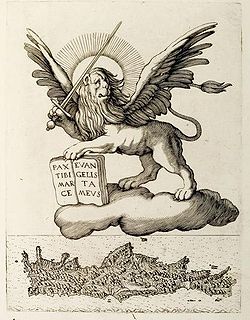Marco Boschini (1602–1681) was an Italian painter and engraver of the early Baroque period in Venice.

He was born in Venice, and was educated in the school of Palma il Giovane. He painted The Last Supper for the sacristy of San Girolamo at Venice. He also distinguished himself as an engraver; for example, he engraved and tinted in aquaforte paintings of Bartolo Ceru.[1]
As a writer on art, he was the author of several publications, such as: La Carta del Navegar pittoresco (1660), a panygeric poem about Venetian painting; Le minere della pittura veneziana (1664) and Le ricche minere della pittura veneziana (1674), two city guides of Venice; I gioieli pittoreschi. Virtuoso ornamento della città di Vicenza (1676), a city guide of Vicenza.
Boschini actually earned the most of his income as an art seller, working as an agent for (among others) cardinal Leopoldo de' Medici.
- Descrizione di tutte le pubbliche pitture della Città di Venezia e isole circonvicine o sia Rinnovazione delle Ricche Minere. by Marco Boschini. Presso Pietro Bassaglia, Venice. 1732.
The major Venetian painters for which he has brief biographies in his text, and arranged in general chronologic order, are:
References edit
- ^ Biographical History of the Five Arts being memoirs of the lives and works. by Shearjashub Spooner, 1867, page 190.
- Bryan, Michael (1886). Robert Edmund Graves (ed.). Dictionary of Painters and Engravers, Biographical and Critical. Vol. I A-K. London: George Bell and Sons. p. 161.
- De Boer, Waldemar H. (2008). Marco Boschini, I gioieli pittoreschi. Virtuoso ornamento della città di Vicenza (1676). Edizione critica illustrata con annotazioni. Florence, Italy: Centro Di.
- Wasmer, Marc-Joachim (2009), Marco Boschini, "Breve Instruzione". Eine stilkritische Einführung in "Le ricche minere della pittura veneziana". Italienisch-Deutsche Edition, 2 Bde., Diss. Universität Bern, 1994, Bern: Selbstverlag.